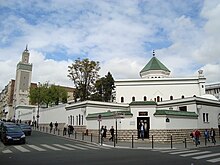
The Muslim diaspora is the diasporic group of Muslims whose ancestors emigrated from the long-standing regions of the Muslim world and the national homes of the Muslim peoples, including Asia, the Palestinian and Israeli regions, and others, although mainly comprise the Middle East and North Africa along with parts of South and Southeast Asia.
History
See also: Spread of Islam, Immigration to India § Medieval era, and Islam in the Americas § Immigrant Muslims in AmericaAfrican Muslim slaves were brought to the Americas during the Atlantic slave trade. From the 19th century onwards, Muslims began voluntarily migrating to the United States, with the Immigration and Nationality Act of 1965 greatly opening up immigration to nonwhite communities in general.
Since the 1960s, many Muslims have migrated to Western Europe. They have arrived as immigrants, guest workers, asylum seekers or as part of family reunification. As a result, the Muslim population in Europe has steadily risen.
Current demographics
A Pew Research study from 2020 estimates that approximately 80 million Muslims make up 29% of all international migrants, slightly above their 25% share of the global population. The majority of these migrants are concentrated in the Middle East-North Africa region (40%), followed by the Asia-Pacific area (24%), Europe (20%), and sub-Saharan Africa (10%), with only 6% in North America. Nearly half of the Muslim migrant population originates from Asia and the Pacific, with one-third from the Middle East and North Africa and 13% from sub-Saharan Africa. Syria has the highest number of Muslim migrants at about 8.1 million, largely due to the Syrian civil war since 2011, with many relocating to Turkey and Lebanon. India is the second-largest source of Muslim migrants, contributing around 6 million, and Afghan migrants number approximately 5.5 million, primarily in Iran and Pakistan, fleeing decades of conflict and instability.
Gulf Cooperation Council countries
A 2020 Pew Research study highlights that Saudi Arabia, is the leading destination for Muslim migrants, hosting around 10.8 million, which accounts for 13% of all Muslim migrants globally. The kingdom also ranks third for overall migration, with nearly 40% of its population being foreign-born, the vast majority of whom (80%) are Muslim. Following closely is the United Arab Emirates, which is home to over 6 million foreign-born Muslims, making it the second most popular destination. Like Saudi Arabia, the UAE is a wealthy Muslim nation with a significant demand for foreign labor, with international migrants comprising 94% of its population. Most Muslim migrants in both countries primarily come from India.
In the West
Canada
As with immigrants in general, Muslim immigrants have come to Canada for a variety of reasons. These include higher education, security, employment, and family reunification. Others have come for religious and political freedom, and safety and security, leaving behind civil wars, persecution, and other forms of civil and ethnic strife. In the 1980s, Canada became an important place of refuge for those fleeing the Lebanese Civil War. The 1990s saw Somali Muslims arrive in the wake of the Somali Civil War as well as Bosniaks fleeing the breakup of the former Yugoslavia. However Canada has yet to receive any significant numbers of Iraqis fleeing the Iraqi War. But in general almost every Muslim country in the world has sent immigrants to Canada – from Pakistan, Bosnia and Herzegovina and Albania to Yemen and Bangladesh.
Europe

Islam is the second-largest religion in Europe after Christianity. Although the majority of Muslim communities in Western Europe formed as a result of immigration, there are centuries-old indigenous European Muslim communities in the Balkans, Caucasus, Crimea, and Volga region.
From 1990 to 2020, the percentage of Muslims among all migrants residing in Europe rose from 16% to 18%, making them the third-largest religious migrant group in Europe. This increase is primarily attributed to higher migration rates from Algeria, Morocco, Syria, Turkey and Pakistan. In contrast, the proportion of religiously unaffiliated migrants declined, while the share of Christians remained constant. This stability among Christians can be linked to the earlier waves of migration from Russia, with many individuals relocating or passing away.
The exact number of Muslims in Europe is unknown but according to estimates by the Pew Forum, the total number of Muslims in Europe (excluding Turkey) in 2010 was about 44 million (6% of the total population), including 19 million (3.8% of the population) in the European Union. A 2010 Pew Research Center study reported that 2.7% of the world's Muslim population live in Europe.
Latin America
A survey conducted by the Pew Research Center in 2010 found that Muslims make up 0.1% of all of Latin America's population. Based on other estimates, there are 100,000 Muslims in Latin America, mainly concentrated in Brazil, Mexico, Jamaica and Argentina, with smaller concentrations in Venezuela, Haiti, Colombia and Paraguay. Most of these Latin American Muslims are from either Lebanese, Syrian origin.
Suriname has the highest percentage of Muslims in its population for the region, with 13.9% or 75,053 individuals, according to its 2012 census. Islam came to Suriname with immigrants from Indonesia (Java) and South Asia (today India, Pakistan and Bangladesh).
United States
Islam is the third-largest religion in the United States (1.1%), behind Christianity and Judaism. The Association of Statisticians of American Religious Bodies in its 2017 US Religion census estimated that 1.1% (or 3,450,000) of the population of the United States are Muslim. In 2017, twenty states, mostly in the South and Midwest, reported Islam to be the largest non-Christian religion.

From the 1880s to 1914, several thousand Muslims immigrated to the United States from the former territories of the Ottoman Empire and British India. The Muslim population of the U.S. increased dramatically in the second half of the 20th century due to the passage of the Immigration and Nationality Act of 1965, which abolished previous immigration quotas. About 72 percent of American Muslims are immigrants or "second generation". By race, in 2014, 38% were non-Hispanic white (including Arabs and Iranians, up from 32% in 2007), 28% were Asian (mostly Indians, Pakistanis, and Bangladeshis, up from 20% in 2007), 28% were black (down from 32%), 4% Hispanic (down from 7%), and 3% of mixed or other race (down from 7%). Since 2007, the black proportion had shrunk, while the white and Asian proportions had grown, mainly due to immigration as most black Muslims were native U.S. blacks.
Community relations
Muslim diaspora and its countries of origin
The intersection between the Muslim diaspora's relationship with its ancestral homelands and the Muslim diaspora's relationship with foreign Islamic communities as part of the global Ummah has been called into question by some in the host countries of the diaspora, with scholars offering different ways of approaching the connections between the two relationships.
Muslim diaspora and its host countries
In the West
See also: Multiculturalism and Islam and Immigration to the Western world § Muslim immigrationMuslims have become an integral part of almost every Western country. There is sometimes a journey to seek understanding between the diaspora's Islam-influenced values and the Western values of their host countries, with some European countries having growing far-right populist movements against Muslims, such as with Geert Wilders in the Netherlands.
A February 2017 poll of 10,000 people in 10 European countries by Chatham House found on average a majority (55%) were opposed to further Muslim immigration, with opposition especially pronounced in a number of countries: Poland (71%), Austria (65%), Hungary (64%), Belgium (64%), and France (61%). Except for Poland, all of those had recently suffered jihadist terror attacks or been at the centre of a refugee crisis. Of those opposed to further Muslim immigration, 3/4 classify themselves as on the right of the political spectrum. Of those self-classifying as on the left of the political spectrum, 1/3 supported a halt.
See also
References
- Moghissi, Haideh (2007-01-24). Muslim Diaspora: Gender, Culture and Identity. Routledge. ISBN 978-1-135-98541-7.
- Silvestri, Sara (2016). "Misperceptions of the 'Muslim Diaspora'". Current History. 115 (784): 319–321. ISSN 0011-3530.
- Flodin-Ali, Yasmine (2023-04-19), "History of Muslims in the United States", Oxford Research Encyclopedia of Religion, doi:10.1093/acrefore/9780199340378.013.900, ISBN 978-0-19-934037-8, retrieved 2024-10-09
- Kramer, Stephanie (19 August 2024). "The Religious Composition of the World's Migrants" (PDF). Pew Research Center.
- Kramer, Stephanie (19 August 2024). "The Religious Composition of the World's Migrants" (PDF). Pew Research Center.
- Statistics Canada. "2001 Census of Canada". Government of Canada. Archived from the original on 2021-02-27.
- "Global religious futures Europe". Archived from the original on 2022-12-12. Retrieved 2019-08-07.
- Cesari, Jocelyne (January–June 2002). "Introduction - "L'Islam en Europe: L'Incorporation d'Une Religion"". Cahiers d'Études sur la Méditerranée Orientale et le monde Turco-Iranien (in French). 33. Paris: Éditions de Boccard: 7–20. doi:10.3406/CEMOT.2002.1623. S2CID 165345374. Retrieved 21 January 2021 – via Persée.fr.
- Cesari, Jocelyne, ed. (2014). "Part III: The Old European Land of Islam". The Oxford Handbook of European Islam. Oxford: Oxford University Press. pp. 427–616. doi:10.1093/oxfordhb/9780199607976.001.0001. ISBN 978-0-19-960797-6. LCCN 2014936672. S2CID 153038977.
- Clayer, Nathalie (2004). "Les musulmans des Balkans Ou l'islam de "l'autre Europe"/The Balkans Muslims Or the Islam of the "Other Europe"". Religions, pouvoir et société: Europe centrale, Balkans, CEI. Le Courrier de Pays de l'Est (in French). 5 (1045). Paris: La Documentation française: 16–27. doi:10.3917/cpe.045.0016. ISSN 0590-0239 – via Cairn.info.
- Kramer, Stephanie (19 August 2024). "The Religious Composition of the World's Migrants" (PDF). Pew Research Center.
- "Chapter 1: Religious Affiliation". The World's Muslims: Unity and Diversity. Religion & Public Life Project. Washington, D.C.: Pew Research Center. 9 August 2012. Archived from the original on 30 January 2023. Retrieved 18 February 2023.
- Analysis (19 December 2011). "Global religious landscape: Muslims" (PDF). Pewforum.org. Archived (PDF) from the original on 2018-03-23. Retrieved 17 August 2012.
- Klich, Ignacio; Lesser, Jeffrey (1996). "Introduction: "Turco" Immigrants in Latin America". The Americas. 53 (1): 1–14. doi:10.2307/1007471. ISSN 0003-1615. JSTOR 1007471.
- 2012 Suriname Census Definitive Results Archived 2015-09-24 at the Wayback Machine. Algemeen Bureau voor de Statistiek - Suriname.
- "Religious Landscape Study". Pew Research. April 2015. Archived from the original on March 29, 2016. Retrieved April 2, 2019.
- "New estimates show U.S. Muslim population continues to grow". Pew Research Center. January 3, 2018. Retrieved August 16, 2018.
- "U.S. Religion Census". U.S. Religion Census. Retrieved 12 November 2022.
- Edward E. Curtis, Muslims in America: A Short History (2009) ch 1
- "Muslim Immigration After 1965". Carleton College. Retrieved March 12, 2021.
- "The Future of the Global Muslim Population". The Pew Forum on Religion & Public Life. January 27, 2011. Archived from the original on April 7, 2013. Retrieved October 30, 2011.
- Wilgoren, Jodi (2001-10-22). "A Nation Challenged: American Muslims – Islam Attracts Converts By the Thousand, Drawn Before and After Attacks". The New York Times. ISSN 0362-4331. Retrieved 2021-03-25.
- "America's Changing Religious Landscape". Pew Research. May 12, 2015. Archived from the original on June 23, 2016. Retrieved May 15, 2015.
- Shams, Tahseen (2021-03-01). "Homeland and Heartland: Conceptualizing the "Muslim" "Diaspora"". Diaspora: A Journal of Transnational Studies. 21 (1): 47–63. doi:10.3138/diaspora.21.1.2020-11-03. ISSN 1044-2057.
- "Muslim Diaspora in the West: Negotiating Gender, Home and Belonging". Routledge & CRC Press. Retrieved 2023-11-17.
- "The One Percent Problem: Muslims in the West and the Rise of the New Populists". Brookings. Retrieved 2024-05-16.
- "What Do Europeans Think About Muslim Immigration?". Chatham House. Archived from the original on 2018-03-10. Retrieved 2018-09-28.
| Diasporas | |||||||||||||||||
|---|---|---|---|---|---|---|---|---|---|---|---|---|---|---|---|---|---|
Africa |
| ||||||||||||||||
| Asia |
| ||||||||||||||||
| Europe |
| ||||||||||||||||
| Oceania | |||||||||||||||||
Western Hemisphere |
| ||||||||||||||||
| Other diasporas |
| ||||||||||||||||
| Related articles | |||||||||||||||||
| Islam topics | |||||||||||||
|---|---|---|---|---|---|---|---|---|---|---|---|---|---|
| Outline of Islam | |||||||||||||
| |||||||||||||
| |||||||||||||
| |||||||||||||
| |||||||||||||